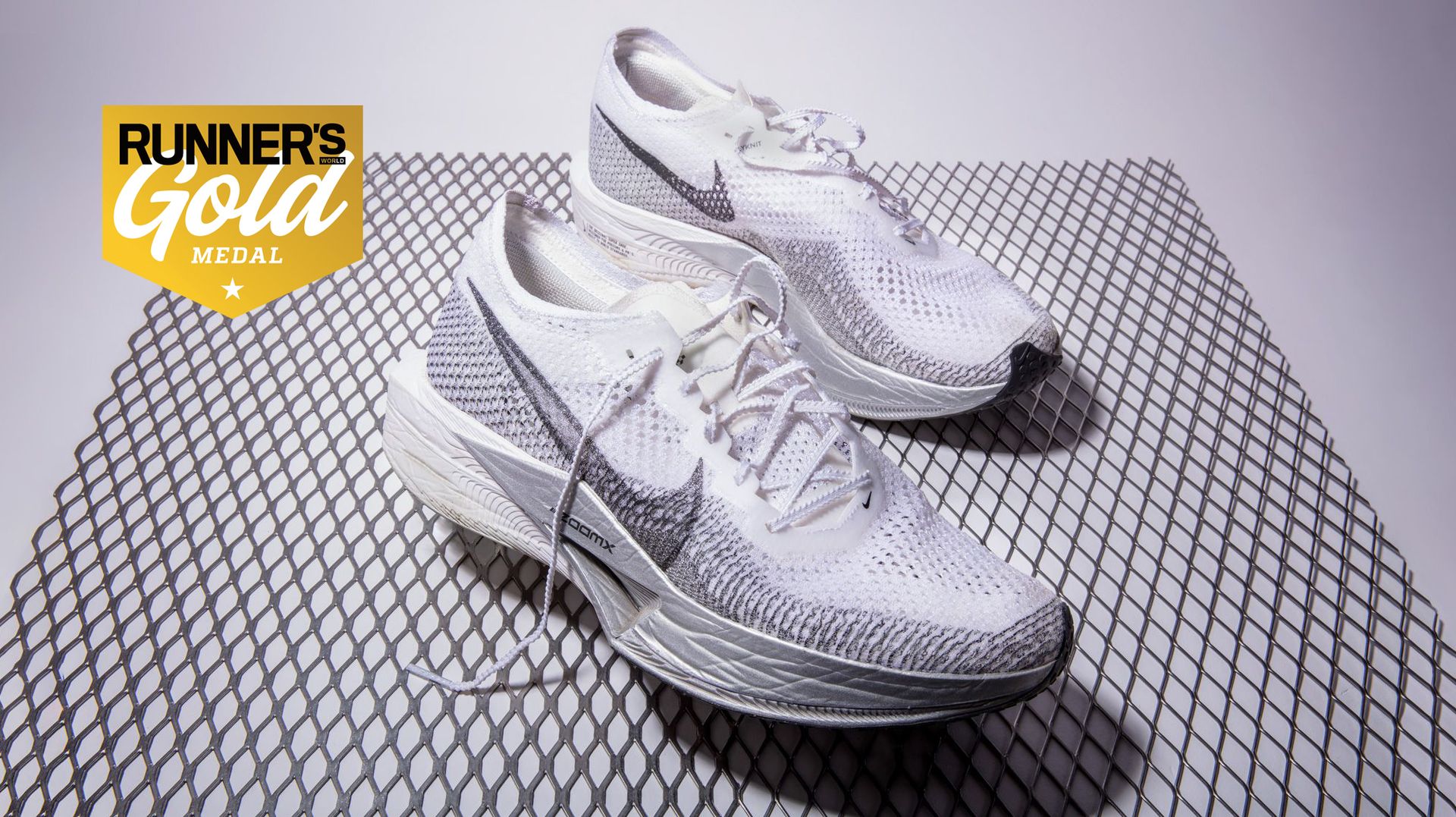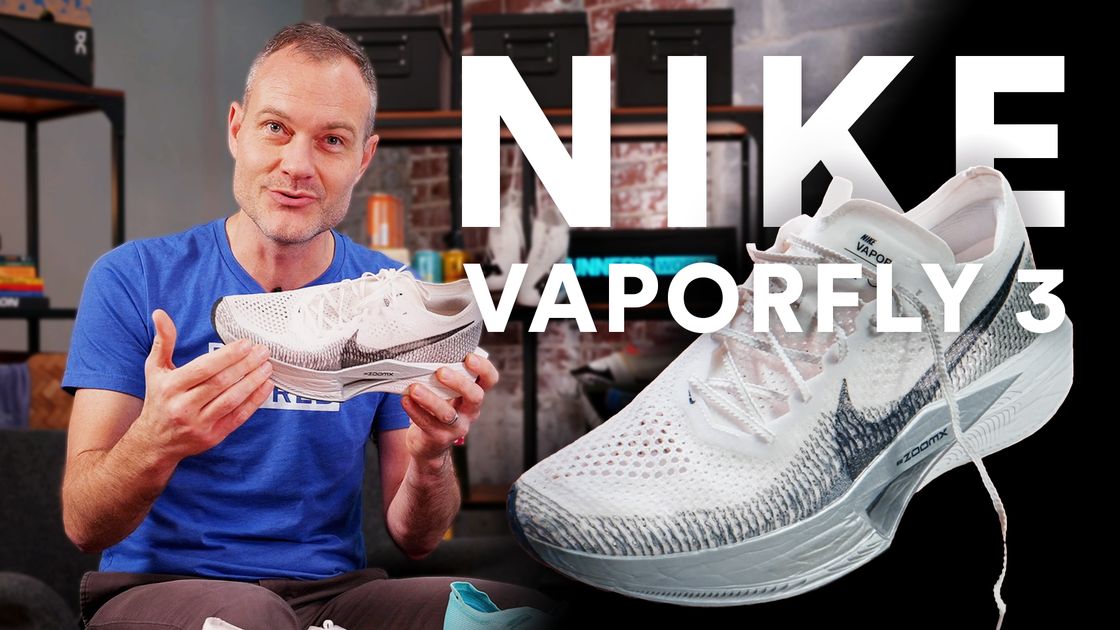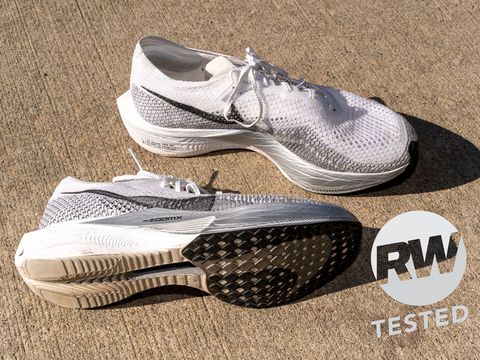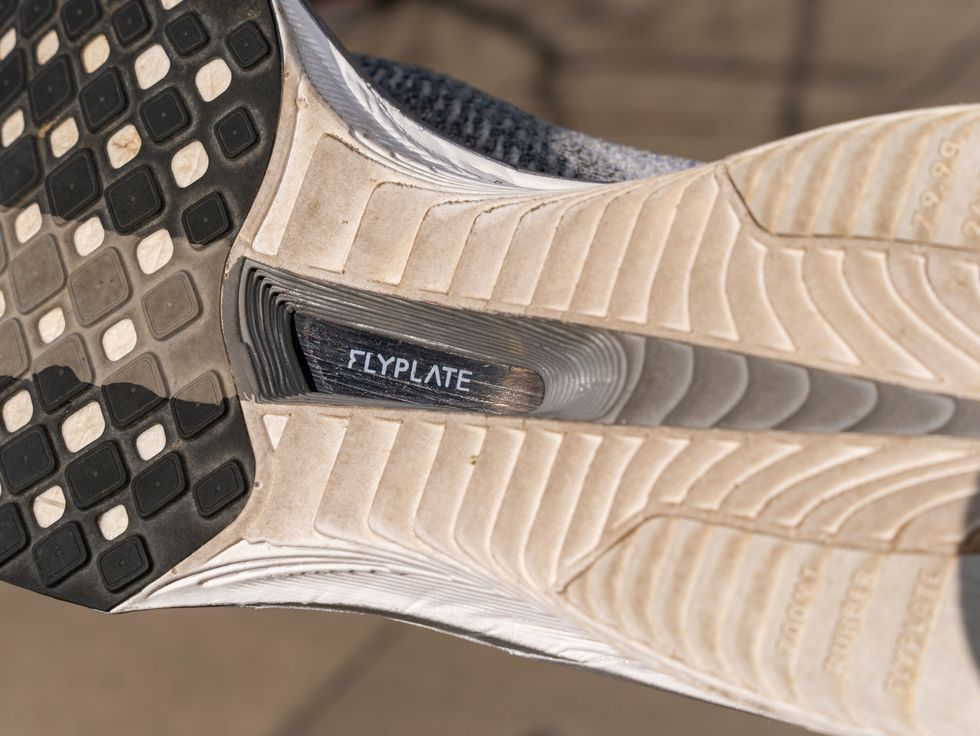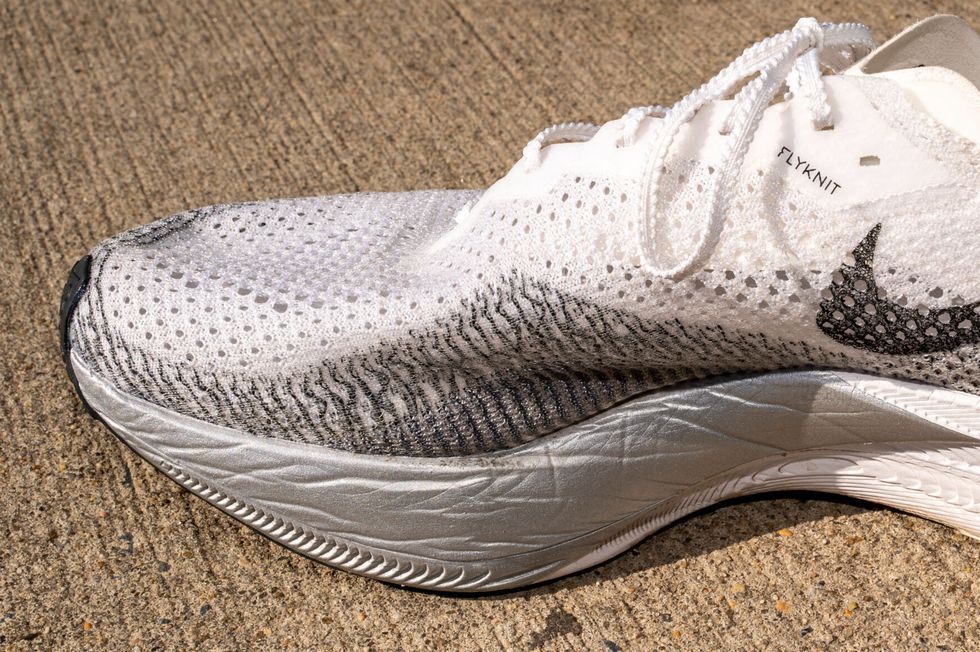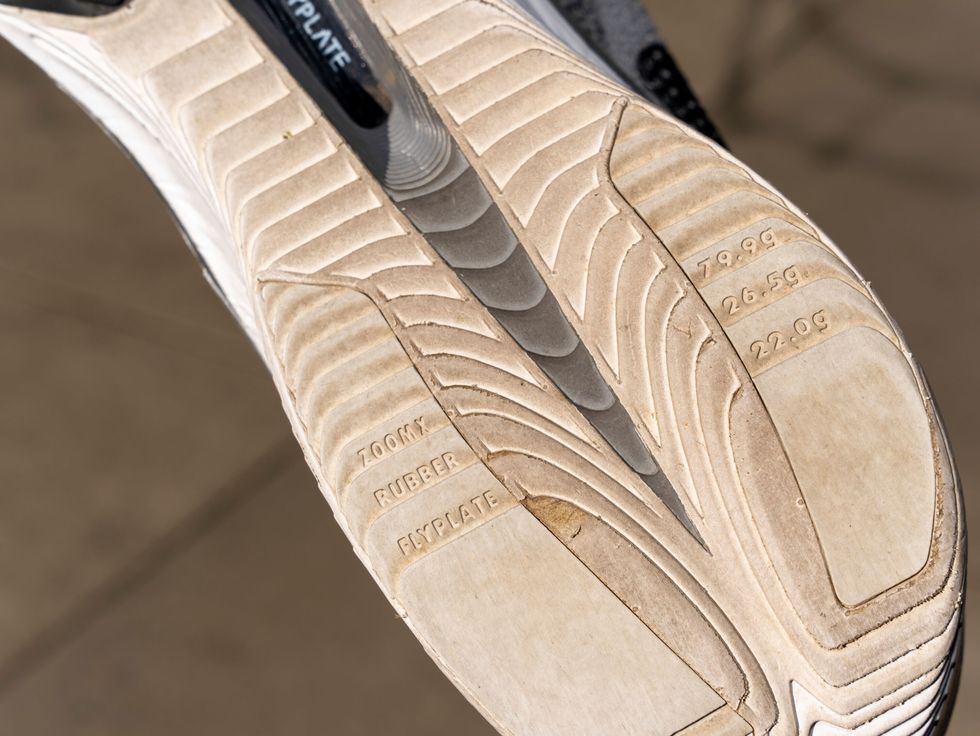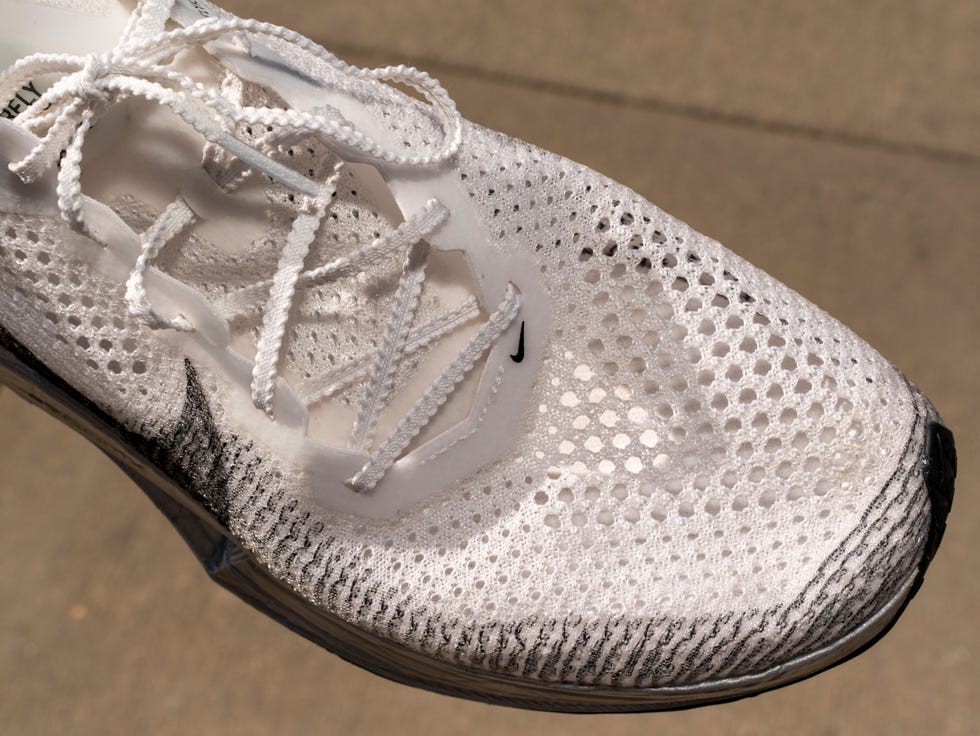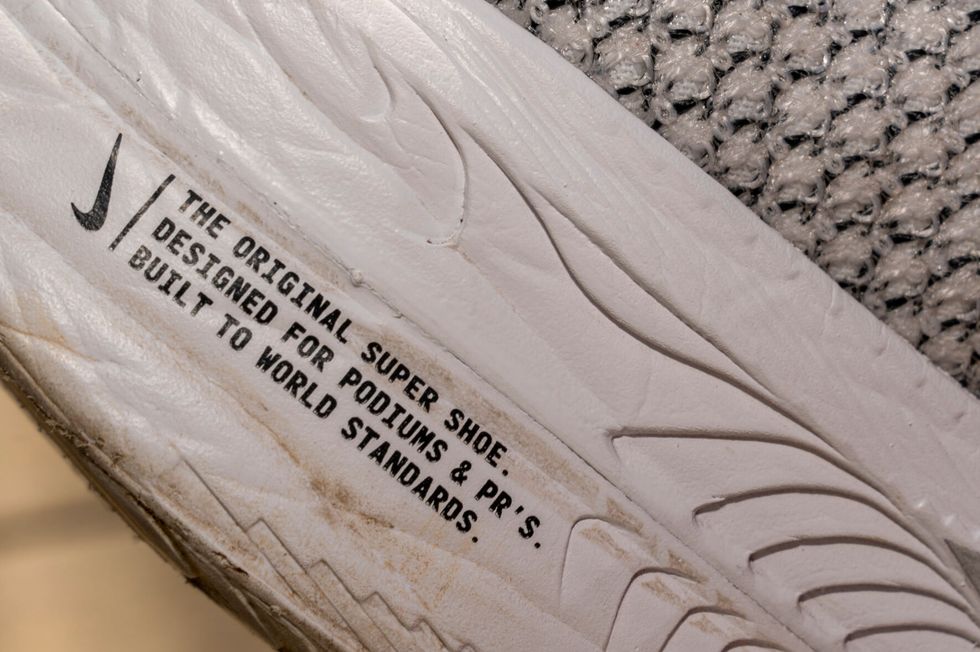Look at the lead pack of any major marathon and you’ll see a sea of Vaporfly. Even though Eliud Kipchoge wore the $275 Alphafly to break the two-hour barrier, most runners—from the elite wave back to BQ hopefuls—reach for the Vaporfly. But, in the recent Majors, the third version was nowhere to be seen. We didn’t see a single VF3 prototype among the top 10 shoes across the finish line at the New York City Marathon. The Nike-sponsored elites were still lacing up the ZoomX Vaporfly Next% 2.
(As of February 3, 2023, there’s still no “Vaporfly 3” listed on the World Athletics list of approved shoes, but there are two Nike “development shoes” highlighted in blue that have been given clearance for competition. You can find the PDF list under Manuals & Guidelines on the World Athletics website.)
By then, though, I already had a pair of the Vaporfly 3 for testing. The shoe won’t be available for purchase until March 2023, but I’ve had the shoe for nearly four months of workouts and racing, and I can report that the third iteration feels just as lively and fast as the previous two, while delivering better stability. Let’s jump into what’s new and how it performs.
Price: $250
Weight, claimed: 7.0 oz (men’s 10), 5.8 oz (women’s 8)
Drop: 8 mm
Availability: March 2023
The RW Takeaway: Nike’s $250 marathon racing shoe gets a significant update to reduce weight and make it even more propulsive. After four months of training and racing, we’ve also found it’s more stable.
Preceded By: Vaporfly 4%, Vaporfly Next%, Alphafly Next% 2
Key Tech: ZoomX midsole, carbon-fiber Flyplate, Flyknit upper, lightweight rubber outsole
Race Tested: Harrisburg Marathon 2:57:49, Cardiac Classic 5K on Thanksgiving Day 17:40, Candy Cane 5K in Bethlehem, PA 17:23
A Racer Rebuilt From the Ground Up
The third version of the Vaporfly is essentially an entirely new shoe, but it doesn’t deviate too far from the original model. Nike didn’t want to reinvent a shoe that was already working so well, and looked to make small tweaks that improve upon the existing racer. Even so, it uses all-new components. As has become typical in the running shoe industry, running shoes only get updated every two years—the in-between year is reserved for small tweaks to the fit and upper materials, but the foam and rubber typically remain untouched.
Nike overhauled the Vaporfly from the rubber up, looking to make the third version the lightest yet. In my men’s size 12, I see only a 0.1-ounce drop from version 2 (my pink pair of the first Next% was 0.4 ounces lighter still). So, it’s not the lightest ever, but it’s still lighter than competitors like the Asics MetaSpeed Sky+, Saucony Endorphin Pro 3, New Balance FuelCell SuperComp Elite v3, Adidas Adizero Adios Pro 3, and Puma Deviate Elite 2.
One attempt to shave weight came in the way Nike shaped the midsole. It’s still using the same Peba-based material for the foam (Nike calls it ZoomX), which delivers top-of-the-line energy return. That foam is already exceptionally lightweight, but Nike added a cutout on the lateral sidewall—your foot doesn’t need support there—and a small channel under the midfoot to reduce material and shave a couple grams.
An aside: Those little openings also reintroduce “visible tech.” If we flash back more than a decade to the days before minimalism and barefoot running, nearly every shoe touted its unique features—and trademarked names. You had windows showing air pockets, gel oozing out above foam, plastic bridges under your arch, all in an attempt to make you think this shoe was so advanced it had to be awesome. One of the best things to come from minimalism is that it stripped back all that noise and shoemakers started talking about the runners’ needs rather than the product’s potential. But, the pendulum is always swinging, and we’re back to an arms race of components. In the case of the Vaporfly 3, it shows you that a carbon-fiber plate is nestled inside that squishy foam. Yes, it’s still there.
Vaporfly 3 Boosts Stability
Rest assured, that foam is still just as soft and bouncy as it ever was. In previous models, that made the shoe a fair bit squirrelly if you require any kind of support. In fairness, this was not a problem unique to Nike. Nearly every maker of super shoes has dealt with this because thick stacks of extremely soft foam are just inherently unstable. But it’s an issue Nike looked to further improve upon here.
“It’s very subtle, if you compare the Vaporfly 3 to the 2,” explained Elliott Heath, Nike Running Footwear Product Manager, via a Zoom video call. “The geometry of the medial side of the shoe, as you get into the arch and the forefoot, is actually like a convex geometry—a little bit of bulging out on the medial side—versus the concave geometry that would allow for a little bit more creasing and a little bit more deflection right there.”
If the foam doesn’t crease and flex quite as much, it’ll feel a bit firmer, of course. In the case of this tweak, it boosts stability as you progress to toe-off and pronate inward.
In my testing of the shoe, it’s one of the few differences I noticed. I raced in the Vaporfly 3 three times, including the Harrisburg Marathon in November. There, I was shooting for a sub-3 finish on a two-loop course that included a lot of sharp turns. In the larger racing landscape, 6:40 pace isn’t terribly fast, but it’s quick enough to give you pause if you know you’re going to slide off the side of the shoe when you make a hard, 90-degree turn. But that wasn’t a problem at all in this shoe. I never felt like I was smashing the platform, and the upper felt locked-in (more on this later). And, if you watch the video above, you’ll see me demonstrating this by taking a 180 around a traffic cone. There’s more movement than I’d like, ideally, but the shoe kept me upright and delivered more confidence as I changed directions.
More ZoomX Equals More Bounce
Take a look at that new rubber outsole. Gone: Say “bye bye” to the big, flat slab under the forefoot. It’s been replaced with a web of diamond-shaped lugs—think waffle sole, rotated 45 degrees, with cutouts. The main reason for the change is weight savings, but Nike also made the tweak to boost the shoe’s energy return. To do so, it made the rubber 2mm thinner than on previous versions, and replaced it with 2mm of ZoomX foam under the forefoot. This is the same approach it took with the Alphafly Next% 2, by the way.
Nike didn’t report any energy return figures nor give the shoe any digit-percent-increase-in-efficiency name, but says the Vaporfly 3 fares better. “The overall stack [height] in the forefoot is the same,” Heath explained, “but we’ve essentially swapped out a couple millimeters of rubber or outsole material for more ZoomX foam underfoot. And that allows the most energy return we’ve ever had in a Vaporfly, without kind of changing the overall build of the shoe.”
That stands to reason: Foam is lighter than rubber and ZoomX delivers better spring, as we know from previous lab testing. (Important note: We have not yet received a men’s size 9 or women’s size 7 to perform mechanical tests in our lab and compare against previous versions, so my observations are purely based on my own wear-testing.)
Small changes in cushioning and energy return are nearly impossible for a runner to perceive. Sure, you can easily tell the difference between an extremely thin, hard sole versus one that’s thick and squishy. But, as the differences become more subtle, they’re harder to distinguish without the use of precise instruments. And, that’s what I found. Running in both the Vaporfly 2 and 3, the cushioning and energy return felt the same. If I were blindfolded, the only way I would know the difference between the shoes is that the Vaporfly 3 is quieter and feels a little smoother when I’m running at race pace. As mentioned above, the new construction eliminated that big slab of rubber which slapped the pavement.
A Nod to Us Weight Weenies
One final detail about Nike’s obsessive pursuit of weight for the Vaporfly 3: It included the actual weights for the components of the shoe inset into the rubber patches under the heel. For example, my size 12 has 79.9 grams of ZoomX foam, 26.5g of rubber, and a 22.0g carbon-fiber plate. Those figures are specific to each size, so if you wear a smaller shoe, your parts will check in lighter.
Is the Flyknit Wrap Too Snug?
In the short lifespan of the Vaporfly shoe, Nike has been all over the place with upper construction. The debut model used an engineered mesh that was quickly swapped out for Flyknit. But that first “FK” model was too stretchy for some, so the Next% debuted with a ripstop nylon-like material. I loved that one because it was insanely lightweight (see my note above), but also didn’t hold any water during rainy races—I was thankful for that at the 2019 Vermont City Marathon, which was delayed by thunderstorms and the first half was held on soaked pavement.
Nike is bringing back Flyknit, but I found this upper has absolutely no stretch at all. It’s extremely thin and breathable, with huge holes over the top of the toes—you can easily read writing on your socks. In testing, I loved the ventilation but longed for a little more flexibility. I laced my shoes up a little too tightly when I headed to the start line in Harrisburg, apparently, because the top of my foot was screaming late in the marathon. (There’s also no tongue padding to protect you from lace pressure.)
Everything else, however, felt great. Having executed my 10-10-10 race plan well, I found the shoes responded as I picked up the pace after 20 miles. Like earlier versions, the shoes helped keep my legs fresh and rewarded me with extra speed when I started to put in real work. But next time around, I’ll leave a little wiggle room when I tie my shoes.
Here’s What Didn’t Change
Embedded deep in the slabs of ZoomX foam remains a carbon-fiber Flyplate. That’s unchanged from earlier versions, with a curved, spoon-like shape that gives the sole its stiff, snappy ride and reduces the effort required from each stride.
Also, the price is inflation-resistant. In 2017, the 4% debuted at $250. It became the benchmark for any great shoe. If a shoe is priced less than that, the implication is that it might not be as fast or as good. It also provided cover for manufacturers to jack up prices of other shoes, which had largely been held in check for many years. So, we have to take the good with the not-so-good.
And, lastly, the brashness of the Swoosh is still intact. I mean, it takes a certain amount of swagger to not only say a shoe is going to make you faster, but to also slap a label on the shoe showing you just how much faster—4% was technically a boost in running economy. Nike didn’t do that this time, but is still letting the competition know it has some ground to make up by putting the following message on the heel foam:
THE ORIGINAL SUPER SHOE.
DESIGNED FOR PODIUMS & PR’S.
BUILT TO WORLD STANDARDS.
Honestly, I love the sass.
Jeff is Runner-in-Chief for Runner's World, guiding the brand's shoes and gear coverage. A true shoe dog, he's spent more than a decade testing and reviewing shoes. In 2017, he ran in 285 different pairs of shoes, including a streak of 257 days wearing a different model.
